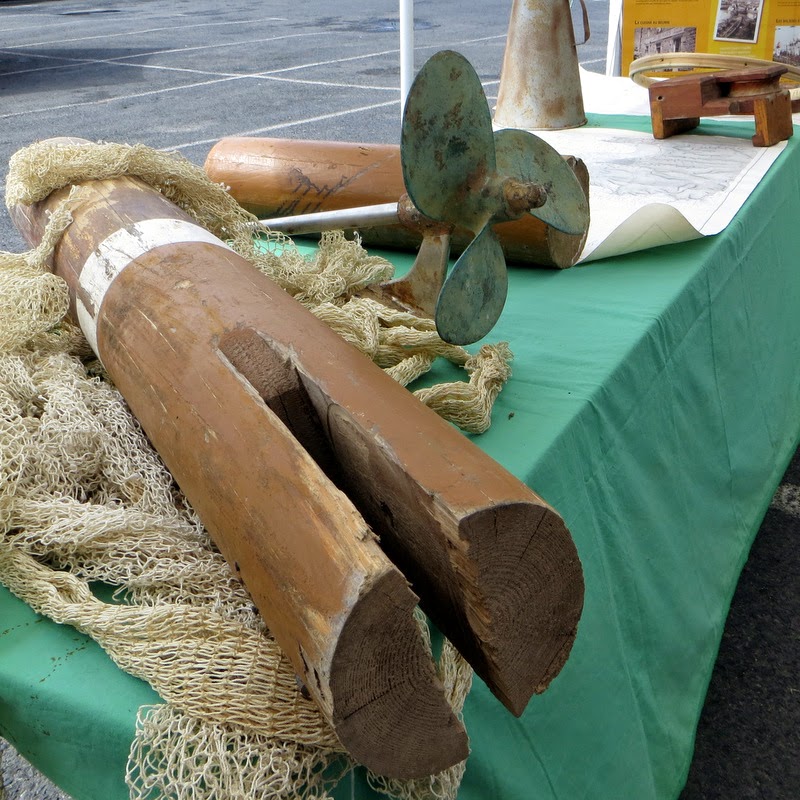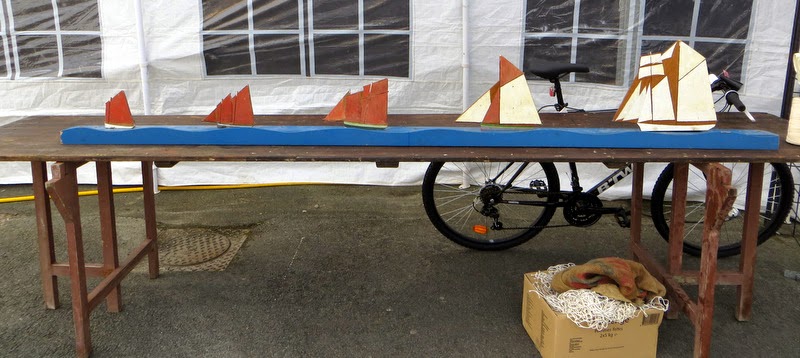Last weekend, we headed up to Erquy to take a special 20th anniversary trip on the Sainte Jeanne - it was the boat's anniversary, not ours. As we later learned, she was wrecked in the 1930s off Paimpol, by the actions of a skipper cutting corners by overloading her and relying on a recently added engine to get him out of trouble which then broke down. She was rebuilt and relaunched in 1994. Needless to say, I took a lot of photos, and Tom took some more with my camera, which it's taken me a week and more to sort and edit.
It was a day of a high tidal coefficient, something we've kind of known about in the abstract, but have lately become aware of and interested in, after inadvertently making an evening outing a little further down the bay a few weeks before and finding our usual walking beach non-existent, familiar rocky landmarks disappeared, and the sea beating at the cliff stairs at our feet. It was curiously exciting and magical and made me think of the Franklin's Tale. (It seems the town of St Malo is even trying to make a tourist attraction of this phenomenon.)
So, although it was nothing like the lowest point of the tide that day, when we arrived in very good time so as to get a parking space, there was not much sea to be seen - all that we could see-see-see was the bottom of the deep blue sea-sea-sea, in fact.
But we also saw plenty of people enjoying an old fashioned seaside experience,
some having less traditional fun,
And quite a few happy dogs sharing the day, the ice cream and the tidal mud.
all of which did our hearts good.
The Sainte Jeanne, which we'd been told would leave from the harbour wall, was not to be seen there. Le Grand Lejon was there, but clearly wasn't going anywhere just yet.
Her crew didn't seem too bothered, they sat around nattering and lunching and making fairly merry. After a while they made to hoist a sail or two.
the main one had a picture of the boat painted on it, thereby creating an always pleasing (to me anyway) mise-en-abyme effect.
Don't worry, though, we were told, the Ste Jeanne was in open water the other side of the fishing quay, and we would be conveyed to her by a smaller vessel. So we went to have a look.
On the way we saw the official tender, painted in matching livery, or whatever boats paintwork is called. It seemed a tiny cockleshell to carry many people, we thought.
Passing the fishing port, very much the business end of Erquy, there were lots of examples of the kind of counter, original, spare and strange stuff, lines and shapes and textures and colours, that I find hard to pass by, though I didn't linger too long.
and a more artfully arranged exhibition of older gear and tackle and trim, chandlery, books, maps and prints:
as well as some models of different kinds of old working sailing boats.
Another very minute detail of something, which I reckon is worthy of a digression, was to be spotted down a drain. (And if, like some, myself included, bits of workaday and rugged cast iron street furniture float your boat, the drain cover in itself is worth looking at. No? OK.)
What I spied through the grill, just about visible here as three white stripes, I recognised as a netting needle. When I was about eleven, I had to endure school needlework and 'handwork' lessons. Despite having stitched and worked a sewing machine and made all manner of things quite competently with my hands from almost before I could walk, I was a hopeless failure and bottom of the class in these areas of the curriculum. Mostly this worried me not one whit, except that those who shone were allowed as a special privilege to do netting. This involved turning a chair upside down, tying a lot of lengths of string to it, and somehow weaving and knotting in and out of them with a netting needle, around which was wound another length of string. I didn't think this looked a particularly satisfying process, my interest was in the potential product: a hammock. I always wanted a hammock. I'm not sure where I would have put one at the time, since there weren't really two suitable trees in our garden, but I dreamed of one anyway. I do now have one, in fact, not made of netting but very handsome blue and green canvas, which can be hung between the timbers of our open barn thing in the summer, but I don't in fact use it much. However, seeing this tool in this context, I understood for the first time that the technique wasn't simply a bit of leftover Victorian effete hobbywork for nice young ladies and gels, but was and apparently still is really used by fishermen for real fishing nets. In these times when fishing seems a murderous, industrialised, globalised behemoth, and indeed, young ladies and gels occupy their fingers principally with checking their phones and Facebook accounts, I find that rather cheering.
Two other old-fashioned sailing boats and a more modern Bermuda sailed, fibre-glass hulled yacht flapped their sails idly in the fishing harbour while the people on them sat about nattering to one another from one craft to another. We scrambled up the rocks along the harbour wall and saw the Ste Jeanne waiting on the other side.
Unfortunately, the wind direction was such that we couldn't get a nice sideways view of her, but later we were able to. We strolled back to the meeting point and were issued with life jackets, which were rather hot and bothersome and cumbrous,
(To be continued...)























14 comments:
I love your photos - so much fascinating texture and beauty! Looking forward to the rest of the story, Lucy.
So much care taken of anything on a boat, but it still wears hard. Rough beauty, earned.
Thanks for taking us along, Lucy.
So cute to see the little dog experiencing his first 'tidal mud walk'. I'm surprised that his leash was taken off, lying there besides the flip-flops.
No idea if it's true that our 16.8m high tides at The Bay of Fundy' are the highest in the world. We were there during low tide and had no time to wait around. Interesting difference between live boats and the ones in the boat cemetery and .... more to come, good.
Smile Tom, the others don't look any better.
Tidal coefficient. Ah, la belle France, home to a thousand overcharged polysyllables.
Don't wanna smile; I'm fed up. And I look silly!
And where else could I tell what this traffic cop reminds me off.
I was young and whatever when I reached the usual intersection downtown Montreal, on my way to work. I cant remember what was going on there waterwise but I do remember that the traffic cop walked over to me and carried me to the other side.
That was indeed cheering, especially with the Hopkins spice!
Thank you everyone.
Happily, Tom was able to take off his big fat life jacket once we were on the boat proper, but that will come later.
Ellena - yes, I believe it's true about Fundy Bay, I read that when researching the matter!
Robbie - Too true about the polysyllables, they do sometimes seem all too much and very pretentious, but that, perhaps, is Anglo-think, stemming originally from the division between the Norman and Saxon origins of English, and perhaps reinforced by the North/South conflict and also by the conscious reintroduction of Latin elements in the 18th century, which I suppose took place rather more easily in French as an already Romance language. I rather feel the anti-intellectualism of the British and our mistrust of 'big words' have roots which are deep and many. (in French of course, 'gros mots' are something quite other!) American English, and our mockery of their misused and falsely etymologised polysyllables - I once met a Mormon here, a congenial fellow, with whom I embarked on a conversation about the role of church and state, who remarked on how our kings and queens were 'coronated' by the church - is another historical ball game...
'Coéfficient' is used in other contexts where we would simply use a word like 'range', as in 'tidal range'. One of my younger students, not a grandiose or wordy boy at all, said that he chose a particular lycée for his Bac because they offered a good 'coéfficient des matières'.
Marly, sorry, missed you there. You are a lovely reader, you always pick up these things, and you reminded me to put a 'gear and tackle' tag on it too!
Hello Lucy,
If you want to look cool when talking to your students, you can just say "coeff", e.g. "en terminale scientifique, c'est anglais coeff 2 et maths coeff 5 ?"
If you are a keen beachcomber, you can even omit “coefficient”. For example: “Tiens, Yvon Kerangoff est absent aujourd’hui ? Oui, il a pris un jour de congé pour la marée de 115. » Marée de 115 = marée de coefficient 115. Over 100, foraging grounds that are usually immersed can be prospected at low tide. In coastal districts of Brittany, quite a few workers program their days off according to the “coefficients de marée”.
It is always my pleasure to share what you have come across when hanging around by the sea… never enough of old hulls, sails and riggings in that world of plastic!
Glad to see that you are still a member of the “Mise en Abyme” club ;-)
Setu
Setu! Always lovely to hear from you.
Yes, a low turn-out on high coefficient days was something I observed! The favourite foraging was for the delicate bigger pink shrimps they call 'bouquets', and having tasted them I can understand why. And thank you so much for my introduction the the Mise-en-Abyme Club!
You forced me to look up coefficient - which is a good thing. I had in mind that it was a number which might vary and was itself the result of relating several variable values. The one I was most familiar with was coefficient of friction - typically 0.3 when used in connection with a car's external shape. The higher the coefficient the more resistance the car's body presented to air flow.
The second definition in my dictionary was "A number that serves as a measure of some property or characteristic, eg, of a device or a process." I think my definition might just pass muster provided Tom wasn't marking the paper.
I'm not quite sure how the word can be used in connection with tides. "Tide level" seems to do the job well enough.
Indeed Robbie, Tom was quite grumpy about the use of the term in this context, and didn't seem to think it was really justifiable, but more a case of the aforesaid polysyllable addiction. In fact though, it doesn't so much refer to the tidal level but the difference in levels between high and low, so not only does a 'marée 115' cover all the rocks so Dorigen's husband can get home safely (dodgy logic, seems like he'd be more at risk of getting wrecked on them not being able to see them, but a promise was a promise), but also recedes further back than usual, hence everyone minching off work and class to go shrimp hunting! What the actual figures - 20 being the smallest possible difference and 120 the biggest (I think) - I've no idea. Anyway, it's another reason to buy the almanach de facteur every year, aside from the fact they'd probably trash your mail if you didn't.
Post a Comment